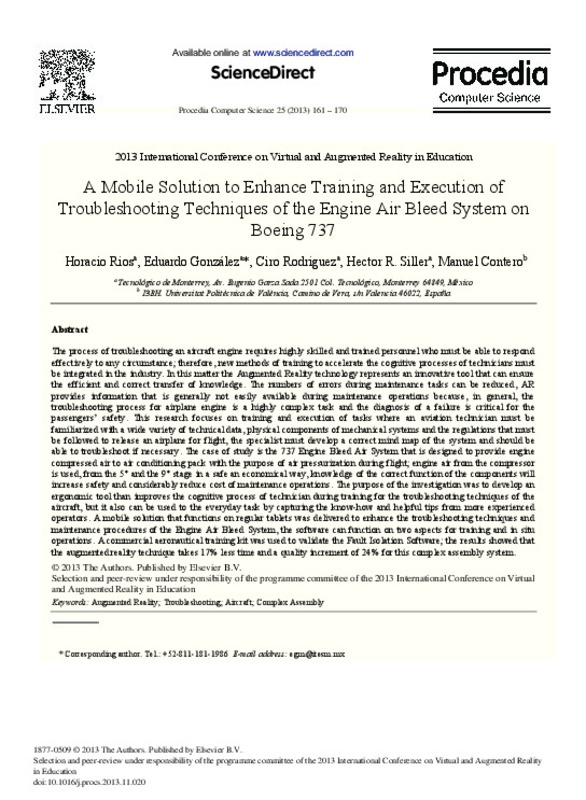JavaScript is disabled for your browser. Some features of this site may not work without it.
Buscar en RiuNet
Listar
Mi cuenta
Estadísticas
Ayuda RiuNet
Admin. UPV
A Mobile Solution to Enhance Training and Execution of Troubleshooting Techniques of the Engine Air Bleed System on Boeing 737
Mostrar el registro sencillo del ítem
Ficheros en el ítem
| dc.contributor.author | Rios, Horacio
|
es_ES |
| dc.contributor.author | Gonzalez, Eduardo
|
es_ES |
| dc.contributor.author | Rodriguez, Ciro
|
es_ES |
| dc.contributor.author | Siller, Hector R.
|
es_ES |
| dc.contributor.author | Contero, Manuel
|
es_ES |
| dc.date.accessioned | 2016-01-18T12:23:23Z | |
| dc.date.available | 2016-01-18T12:23:23Z | |
| dc.date.issued | 2013 | |
| dc.identifier.issn | 1877-0509 | |
| dc.identifier.uri | http://hdl.handle.net/10251/59986 | |
| dc.description.abstract | The process of troubleshooting an aircraft engine requires highly skilled and trained personnel who must be able to respond effectively to any circumstance; therefore, new methods of training to accelerate the cognitive processes of technicians must be integrated in the industry. In this matter the Augmented Reality technology represents an innovative tool that can ensure the efficient and correct transfer of knowledge. The numbers of errors during maintenance tasks can be reduced, AR provides information that is generally not easily available during maintenance operations because, in general, the troubleshooting process for airplane engine is a highly complex task and the diagnosis of a failure is critical for the passengers safety. This research focuses on training and execution of tasks where an aviation technician must be familiarized with a wide variety of technical data, physical components of mechanical systems and the regulations that must be followed to release an airplane for flight, the specialist must develop a correct mind map of the system and should be able to troubleshoot if necessary. The case of study is the 737 Engine Bleed Air System that is designed to provide engine compressed air to air conditioning pack with the purpose of air pressurization during flight; engine air from the compressor is used, from the 5° and the 9° stage in a safe an economical way, knowledge of the correct function of the components will increase safety and considerably reduce cost of maintenance operations. The purpose of the investigation was to develop an ergonomic tool than improves the cognitive process of technician during training for the troubleshooting techniques of the aircraft, but it also can be used to the everyday task by capturing the know-how and helpful tips from more experienced operators. A mobile solution that functions on regular tablets was delivered to enhance the troubleshooting techniques and maintenance procedures of the Engine Air Bleed System, the software can function on two aspects for training and in situ operations. A commercial aeronautical training kit was used to validate the Fault Isolation Software; the results showed that the augmented reality technique takes 17% less time and a quality increment of 24% for this complex assembly system. | es_ES |
| dc.language | Inglés | es_ES |
| dc.publisher | Elsevier | es_ES |
| dc.relation.ispartof | Procedia Computer Science | es_ES |
| dc.rights | Reconocimiento - No comercial - Sin obra derivada (by-nc-nd) | es_ES |
| dc.subject | Augmented Reality | es_ES |
| dc.subject | Troubleshooting | es_ES |
| dc.subject | Aircraft | es_ES |
| dc.subject | Complex Assembly | es_ES |
| dc.subject.classification | EXPRESION GRAFICA EN LA INGENIERIA | es_ES |
| dc.title | A Mobile Solution to Enhance Training and Execution of Troubleshooting Techniques of the Engine Air Bleed System on Boeing 737 | es_ES |
| dc.type | Artículo | es_ES |
| dc.identifier.doi | 10.1016/j.procs.2013.11.020 | |
| dc.rights.accessRights | Abierto | es_ES |
| dc.contributor.affiliation | Universitat Politècnica de València. Departamento de Ingeniería Gráfica - Departament d'Enginyeria Gràfica | es_ES |
| dc.description.bibliographicCitation | Rios, H.; Gonzalez, E.; Rodriguez, C.; Siller, HR.; Contero, M. (2013). A Mobile Solution to Enhance Training and Execution of Troubleshooting Techniques of the Engine Air Bleed System on Boeing 737. Procedia Computer Science. 25:161-170. doi:10.1016/j.procs.2013.11.020 | es_ES |
| dc.description.accrualMethod | S | es_ES |
| dc.relation.publisherversion | http://dx.doi.org/10.1016/j.procs.2013.11.020 | es_ES |
| dc.description.upvformatpinicio | 161 | es_ES |
| dc.description.upvformatpfin | 170 | es_ES |
| dc.type.version | info:eu-repo/semantics/publishedVersion | es_ES |
| dc.description.volume | 25 | es_ES |
| dc.relation.senia | 258388 | es_ES |








